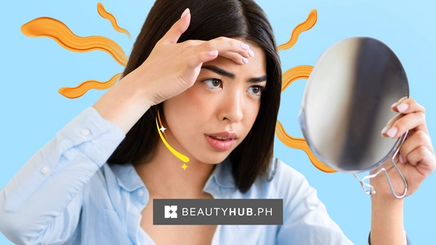
Anyone who’s ever had forehead acne knows how it feels like a personal attack. Red, pus-filled intruders sit prominently on your face in full “main character” mode, defying even the most potent anti-pimple meds. If you’re dealing with chronic acne on your forehead, it would be best to understand why it won’t go away. Then, you’ll get to the root of the problem. Keep reading to learn more about what causes forehead acne and how to deal with it.
Your Hair Products Irritate Your Skin
Dry shampoo and hair gel may save you from a , but they can wreak havoc on your skin. Many contain oil and conditioning agents, which are great for your strands but not so good for the . They can leave a residue that mixes with sweat and sebum, resulting in so-called “pomade acne” or small bumps along the hairline.
According to the , pomade acne should clear once you stop using pore-clogging hair products – including shampoo and conditioner. That’s not to say you can’t have healthy skin and ! Look for haircare and styling products with non-comedogenic or oil-free . Most importantly, thoroughly wash your hair and to prevent build-up from blocking your pores.
Your Skin Needs Exfoliation
The T-zone area has more sebaceous glands than other parts of the face, so it naturally produces more oil. Over time, the excess oil, dead skin cells, and dirt settle into the pores, creating a breeding ground for acne. That’s why one of the most straightforward forehead acne treatments is .
If applied too vigorously, physical scrubs can cause micro-tears. Start with a gentle chemical-based exfoliator once a week. Salicylic acid is a popular BHA known to address acne. You’ll find it in Eskinol Pimple Relief Serum, which helps unclog pores, calms inflammation, and fade pimple marks. It’s also infused with cica and to soothe and repair inflamed skin.
Your Forehead Needs Some Space
The summer season calls for some statement pieces, like . While they spice up your OOTD, they can also trigger forehead acne (uh-oh!). Any enclosed headgear creates a warm, humid environment that promotes the growth of acne-causing bacteria. If you wear one made with synthetic materials, it can also cause friction, leading to inflammation.
Your breakouts may also be a side effect of your . The sweat and oil on your hair can rub against your forehead whenever you move, mixing with makeup, sebum, and grime that may already be blocking your pores.
So, in warm weather, pin up your bangs and remove your hat. Avoid touching your locks too often, and make sure to wash your regularly.
Your Pillowcases Are Dirty
Here’s a disturbing fact that might keep you up at night: a pillowcase has than a toilet seat after one week of use. So, yeah, we’re not being paranoid when we say your dirty sheets most may be the cause of your acne.
Depending on the materials, your pillowcases soak up moisture and other impurities from your hair and skin. , which are smoother and less absorbent, are better options for those prone to breakouts. However, changing your bedding set once a week is still the best course of action. For the sake of your skin, don’t be lazy!
Your Makeup Products and Brushes Are Dirty
Acne caused by makeup is so common that it has its own scientific name: acne cosmetica. Culprits include dirty makeup tools, contaminated products, and improper . Aside from washing your brushes and sponges regularly, clean the surfaces of your palettes with a dry tissue after every use.
Moreover, make sure you . As much as you love ultra-convenient cleansing wipes, they’re not enough to remove long-wearing formulas like waterproof mascara and matte foundation. If you don’t wash your face thoroughly, leftover makeup can block the pores and attract bacteria, leading to irritation, , and breakouts. To prevent this, try the , a gentle way to remove impurities from the skin.
First, dissolve all makeup with Eskinol Pimple Relief Micellar Water, an alcohol-free cleanser that also soothes the skin with cica and green tea extract. Take time to clean all corners of your face, including the hairline, neck, and . Follow with a second cleanse with a regular face wash and continue your skincare routine as usual.
Prevention can go a long way in resolving forehead acne. By practicing a good skincare routine and being mindful of the tools and accessories you use, you’ll have the best chance of banishing those pesky bumps once and for all. For now, differently.